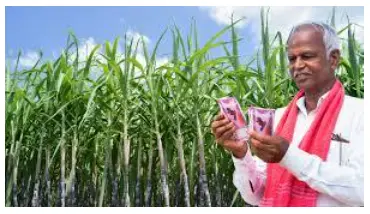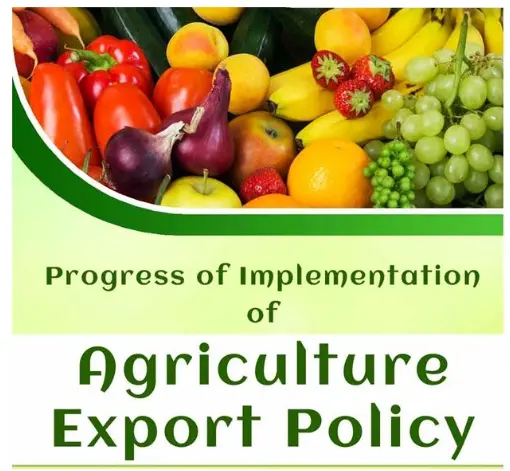Wednesday, 15th May 2024
Child Labor Allegations in Trade Talks with Australia
In News: The recent report by Australia's Joint Standing Committee on Trade and Investment Growth alleging child labor has been strongly denied by the Indian Ministry of Commerce and Industry.
Allegations Made by the Australian Panel:
- The Australian committee's report, based on claims by the Community and Public Sector Union (CPSU) and the State Public Services Federation (SPSF Group), expressed concerns about child and forced labor practices in India.
- The report recommended that the Australian Government incorporate human rights, labor, and environmental chapters in its trade agreements, aligning with conventions and declarations signed by Australia.
Facts Supporting Australia’s Claim:
- According to the 2023 Global Slavery Index estimates by Walk Free, an international human rights group, there were 11 million people living in modern slavery in India in 2021, the highest globally.
- Census 2011 data indicates that out of the total child population (5-14 years) of 259.6 million in India, 10.1 million (3.9%) are engaged in work, while over 42.7 million children are out of school.
India’s Response:
- Child Labour Prohibition: The Indian government refuted the allegations, emphasizing that existing regulations prohibit child and bonded labor.
- Constitutional Protections: India's Constitution safeguards labor rights and authorizes both central and state governments to enact laws such as the Bonded Labour System (Abolition) Act, 1976, to protect workers' rights.
- Strict Licensing and Compliance: All businesses in India must adhere to labor welfare laws prescribed by both union and state governments and are licensed by local governing bodies.
- Comprehensive Records: Processing units maintain detailed records regarding processing, quality checks, employee training, and compliance with regulations.
India’s Legal Framework on Child Labour and Forced Labour:
- Constitutional Rights:
- Article 23 prohibits trafficking in human beings and forced labor, ensuring protection against exploitation and degrading work conditions.
- Article 24 prohibits the employment of children under 14 in factories, mines, or hazardous occupations, aiming to safeguard children's health, development, and access to education.
- Article 39 outlines principles for ensuring equal livelihood rights, protection of workers' health, and children's well-being.
- Legislations Against Child Labour:
- Child Labour (Prohibition & Regulation) Act, 1986, bans employing children under 14 in all work, with exceptions for family businesses and non-hazardous work.
- Juvenile Justice (Care and Protection of Children) Act, 2015, considers working children as "in need of care and protection."
- Legislations Against Forced Labour:
- Bonded Labour System (Abolition) Act, 1976, criminalizes bonded labor and provides for the release and rehabilitation of bonded laborers.
- Central Sector Scheme for Rehabilitation of Bonded Labourer, 2021, offers financial assistance for the rehabilitation of freed bonded laborers.
|
UPSC Previous Year Questions Prelims (2018) Q. International Labour Organization’s Conventions 138 and 182 are related to (a) Child Labour Ans: (a) Q. Consider the following countries:
Which of the above are among the ‘free-trade partners’ of ASEAN? (a) 1, 2, 4 and 5 Ans: (c) Mains (2016) Q. Examine the main provisions of the National Child Policy and throw light on the status of its implementation. |
Source: IE
Charting India's Journey Towards Sustainability
In News: PwC India, a professional services network, has recently released a report titled 'Navigating India's Shift towards Sustainability'.
Key Findings of the Report on Business Responsibility and Sustainability Reporting (BRSR):
- Analysis Scope: The report evaluates how companies are adapting to the Business Responsibility and Sustainability Reporting (BRSR) disclosures mandated by the Securities and Exchange Board of India (SEBI), focusing on the BRSR reports of the top 100 companies for the financial year ending on 31st March 2023.
- Significance of Business Sector: The business sector is recognized as a crucial facilitator in achieving India's net zero vision by 2070, also known as carbon neutrality, aiming to attain an overall balance between greenhouse gas emissions produced and those removed from the atmosphere.
- Key Findings:
- Disclosure Rate: Despite BRSR being a voluntary disclosure, 51% of India’s top 100 listed companies by market capitalization disclosed their data for FY23.
- Emission Reduction Efforts: 34% of companies reduced their Scope 1 emissions, and 29% reduced their Scope 2 emissions.
- Life-cycle Assessment: 44% of top listed companies conducted life-cycle assessments of their products or services.
- Renewable Energy Usage: 49% of companies increased their energy consumption from renewable sources, while 31% disclosed net-zero targets.
- Emission Reduction Initiatives: Key initiatives leading to emission reduction include transitioning to energy-efficient technologies such as LEDs, adopting efficient air-conditioning, ventilation, and heating systems, shifting to renewable energy sources, purchasing carbon offsets, and entering into off-site power purchase agreements.
Significance of the Report for India:
- Sustainability Journey: The report illuminates India’s progress towards sustainability, underlining Environmental, Social, and Governance (ESG) considerations.
- Accountability Encouragement: It encourages companies to be accountable for their sustainability efforts, aligning with the BRSR framework introduced by SEBI.
- Investor Confidence: Transparent disclosure enhances investor confidence, showcasing India's commitment to sustainability and positioning it favorably on the global stage.
- Policy Insights: Policymakers can derive insights from the report to formulate regulations and policies promoting sustainable practices.
- Balanced Growth: Emphasizing the need to balance economic development with environmental and social well-being, the report underscores responsible growth.
Initiatives to Ensure ESG Compliance in India:
- National Voluntary Guidelines (NVGs): In 2011, the Ministry of Corporate Affairs (MCA) released NVGs, setting early standards for ESG disclosure.
- Business Responsibility Reports (BRR): SEBI introduced BRR in 2012 for the top 100 listed entities, later extending it to the top 500 entities in 2015.
- Business Responsibility and Sustainability Report (BRSR): In 2021, SEBI replaced BRR with BRSR, seeking disclosures on performance against the National Guidelines on Responsible Business Conduct.
- Reporting Frameworks: Companies can utilize various reporting frameworks like Global Reporting Initiative (GRI), Carbon Disclosure Project (CDP), and Sustainability Accounting Standards Board (SASB) to demonstrate their commitment to ESG practices.
|
UPSC Previous Year Questions Prelims (2019) Q. Which of the following is issued by registered foreign portfolio investors to overseas investors who want to be part of the Indian stock market without registering themselves directly? (a) Certificate of Deposit Ans: (d) Mains (2016) Q. Economic growth in the recent past has been led by an increase in labour activity.” Explain this statement. Suggest the growth pattern that will lead to creation of more jobs without compromising labour productivity. |
Source: PWC
Smart Cities Mission
In News: The flagship program of the NDA-1 government, the Smart Cities Mission (SCM), has been overshadowed in this year's list of electoral pledges and achievements.
Understanding the Smart Cities Mission (SCM)
Overview of the Smart Cities Mission:
- The Smart Cities Mission (SCM) is a Centrally Sponsored Scheme initiated by the Union Ministry of Housing and Urban Affairs (MoHUA) on 25 June 2015.
- Its primary goal is to enhance cities by implementing 'smart solutions' to ensure a decent quality of life for citizens, drive economic growth, and promote sustainable and inclusive development.
- The mission selected 100 cities over five years without a precise definition of a smart city, with the aim of completing the mission by 2020, extended twice until June 2024.
Financial Support and Funding:
- The Central Government allocated Rs. 48,000 crores over five years, averaging Rs. 100 crore per city per year, with an equal contribution required from State/Urban Local Bodies (ULBs).
Main Components of SCM:
- The SCM comprises two main aspects: area-based development and pan-city solutions.
- Area-based development includes redevelopment, retrofitting, and greenfield projects, while pan-city solutions focus on Information and Communication Technology (ICT) initiatives.
- Components further encompass e-governance, waste management, water management, energy management, urban mobility, and skill development.
Achievements of SCM:
- Approximately Rs. 2 lakh crore was allocated for the mission, with Public-Private Partnerships (PPP) playing a significant role.
- An innovative governance model was adopted, with Special Purpose Vehicles (SPVs) led by bureaucrats or representatives from Multinational Corporations (MNCs).
- Despite challenges, the SCM achieved an impressive completion rate of 83%, utilizing Rs. 72,571 crore across 21 sectors.
- Integrated Command and Control Centers (ICCCs) were established in participating cities, facilitating disaster response and urban function management.
Success Stories of SCM:
- Davanagere implemented a successful stormwater drainage system, reducing flooding instances.
- Jabalpur enhanced water supply to households, demonstrating the mission's focus on improving essential services.
- However, challenges persist in retrofitting existing infrastructure with new technologies.
Criticisms of SCM:
- The selection and implementation process of SCM was flawed, lacking adaptability to India's dynamic urbanization.
- SCM projects saw a decrease in total outlay, falling short of the projected capital flow.
- The SPV model deviated from the 74th Constitutional Amendment, resulting in a top-down governance structure.
- Displacement of marginalized communities, such as street vendors, occurred under the guise of executing smart city projects.
- Urban flooding increased due to infrastructure projects disrupting water channels in some towns.
Source: TH
Xenotransplantation
In News: The individual who received the pioneering xenotransplantation surgery with a modified pig kidney recently passed away, with no connection to the transplant identified as the cause of death.
Understanding Xenotransplantation
- Definition:
- Xenotransplantation, as defined by the US Food and Drug Administration (FDA), involves transplanting, implanting, or infusing live cells, tissues, or organs from nonhuman animal sources into human recipients, or using human body fluids, cells, tissues, or organs that have been in contact with live nonhuman animal cells, tissues, or organs ex vivo.
- Purpose:
- The primary objective of xenotransplantation is to address the shortage of human donor organs, particularly in cases such as kidney transplants, where the demand far exceeds the available supply, leading to significant waiting lists and fatalities.
- Historical Context:
- The practice of xenotransplantation dates back to the 1980s, with initial attempts focusing on organs like the heart.
- Since then, advancements have been made in genetic modification and compatibility enhancement techniques.
- Procedure:
- In xenotransplantation, animals, particularly pigs, are selected as organ donors.
- These organs undergo genetic modifications using technologies like CRISPR-Cas9 to make them more compatible with the human immune system.
- This may involve removing pig genes that produce antibodies recognized by the human immune system and incorporating human genes to improve compatibility.
Complications in Xenotransplantation:
- Organ Rejection:
- One of the major challenges in xenotransplantation is preventing the human body from rejecting the transplanted pig organs.
- Techniques such as embedding the pig's thymus gland with the organ can help reduce immune responses.
- Infection Risks:
- There are concerns about potential infections from both known and unknown infectious agents present in the animal organs.
- These infections could spread to recipients and potentially to the broader population.
- Retroviruses:
- Cross-species transmission of retroviruses poses a significant risk in xenotransplantation.
- These viruses may remain latent and cause diseases years after infection.
- Xenotransplantation in India:
- Xenotransplantation procedures have been attempted in India as well.
- In 1997, a surgeon in Assam performed a xenotransplantation procedure by transplanting a pig's heart into a human patient.
- However, the patient passed away shortly afterward, leading to legal repercussions.
Why Pigs Are Preferred for Xenotransplantation:
- Historical Use:
- Pig heart valves have been utilized in human surgeries for over five decades, establishing a precedent for the use of pig organs in transplantation.
- Similarity to Humans:
- Pigs possess anatomical and physiological similarities to humans, making them suitable candidates for xenotransplantation.
- Additionally, their widespread farming makes them a cost-effective and accessible source of organs.
- Size Matching:
- Pigs come in various breeds, offering a range of organ sizes that can be matched to the specific requirements of human recipients, improving the likelihood of successful transplantation.
|
UPSC Previous Year Questions Prelims (2017) Q. With reference to agriculture in India, how can the technique of ‘genome sequencing’, often seen in the news, be used in the immediate future?
Select the correct answer using the code given below: (a) 1 only Ans: (d) Prelims (2022) Q2. Consider the following statements: DNA Barcoding can be a tool to:
Which of the statements given above is/are correct? (a) 1 only Ans: (d) |
Souce - IE
India International Bullion Exchange
In News: SBI has declared its status as the inaugural trading-cum-clearing member of the India International Bullion Exchange (IIBX).
Introduction to India International Bullion Exchange (IIBX) and IFSCA
About India International Bullion Exchange (IIBX):
- Positioned as India's inaugural International Bullion Exchange, the IIBX operates from GIFT City (Gujarat International Finance Tech City) IFSC in Gandhinagar, Gujarat.
- Its vision is to serve as a conduit for importing bullion into India and fostering a world-class bullion exchange ecosystem, promoting trading, investment in bullion financial products, and offering vaulting facilities within IFSCs.
- Aims to facilitate Transparent Price Discovery, Responsible sourcing, and supply chain integrity, alongside Quality Assurance and Standardization.
- Regulated by the International Financial Services Centers Authority (IFSCA), which is responsible for developing and regulating financial products, services, and institutions within IFSCs.
- Offers diversified products and technology at competitive costs compared to Indian exchanges and global counterparts in Hong Kong, Singapore, Dubai, London, and New York.
What is Bullion?
- Bullion denotes physical gold and silver of high purity, typically stored in the form of bars, ingots, or coins.
- Often recognized as legal tender and held as reserves by central banks or institutional investors.
Key Facts about International Financial Services Centers Authority (IFSCA):
- Established as a statutory authority under the International Financial Services Centres Authority Act, 2019 (“IFSCA Act”).
- Mandated to develop and regulate financial products, services, and institutions within International Financial Services Centres (IFSCs).
- Aims to foster global connections, address Indian economy needs, and serve as an international financial platform for the region.
- Predecessors to IFSCA included domestic financial regulators such as RBI, SEBI, PFRDA, and IRDAI, which regulated IFSC businesses.
- GIFT-IFSC stands as India's premier IFSC, marking the inception of IFSCA's regulatory authority.
Source: TOI
United Nations Office on Drugs and Crime (UNODC)
In News: The 2024 World Wildlife Crime Report by UNODC revealed that the rhinoceros and cedar were the animal and plant species most impacted by illegal wildlife trade globally between 2015 and 2021.
Functions and Overview of the United Nations Office on Drugs and Crime (UNODC)
- Overview of the United Nations Office on Drugs and Crime (UNODC):
- The UNODC is globally recognized for its efforts in combating illicit drugs, international crime, and terrorism, with origins dating back to 1997 when it was formed through the amalgamation of the United Nations Drug Control Programme and the Centre for International Crime Prevention.
- Functions of UNODC:
- Education on Drug Abuse: UNODC plays a crucial role in raising awareness worldwide about the dangers associated with drug abuse.
- Strengthening Action Against Illicit Drugs: It works to enhance international efforts to combat the production, trafficking, and crime related to illicit drugs.
- Crime Prevention and Criminal Justice Reform: UNODC focuses on improving crime prevention strategies and supporting reforms in criminal justice systems to bolster the rule of law, foster stable criminal justice structures, and counter the escalating threats posed by transnational organized crime and corruption.
- Terrorism Prevention: With an expanded mandate since 2002, the Terrorism Prevention Branch of UNODC assists member states in ratifying and implementing eighteen universal legal instruments against terrorism, upon request.
- Funding Mechanism: The UNODC primarily relies on voluntary contributions, predominantly from governments, to carry out its diverse range of activities.
- World Wildlife Crime Report:
- The World Wildlife Crime Report, now in its third edition published in 2024, investigates patterns in the illegal trafficking of protected wildlife species.
- It conducts systematic analyses of the harms and impacts of wildlife crime, identifies the driving factors behind wildlife trafficking trends, and assesses the effectiveness of various intervention methods employed to address this issue.
Source: DTE
Chabahar Port Project
In News: India and Iran have recently inked a significant 10-year agreement aimed at the development and management of the Chabahar port. This milestone represents a crucial advancement in the bilateral relationship between the two countries.
Overview of Chabahar Port Project
- Chabahar Port is situated in Iran’s Sistan-Baluchistan province, positioned at the Gulf of Oman's mouth within the Strait of Hormuz.
- It serves as Iran's sole port directly connected to the Indian Ocean and comprises two sections known as Shahid Beheshti and Shahid Kalantari.
- Geographically proximate to nations like Afghanistan, Pakistan, and India, the port stands as a pivotal transit center on the emerging International North-South Transport Corridor (INSTC).
- The INSTC is a multimodal route linking the Indian Ocean and the Persian Gulf to the Caspian Sea through Iran, further extending to northern Europe via Saint Petersburg, Russia.
- Chabahar Port's strategic location positions it to evolve into a significant commercial center in the region.
- Distances from Chabahar to Kandla port in Gujarat stand at 550 Nautical Miles, while the distance to Mumbai is 786 Nautical Miles.
- In May 2016, India entered a trilateral agreement with Iran and Afghanistan to develop the Shahid Beheshti Terminal at Chabahar, marking India's inaugural foreign port venture.
- The agreement aims to establish an international transport and transit corridor centered around Chabahar.
- Key components of the project include the construction of Chabahar Port and a rail line extending from the port to Zahedan.
- The project's vision is to provide India with a route bypassing Pakistan to access Afghanistan and, ultimately, Central Asia.
- Additionally, the port is envisioned to facilitate transit trade between India, Iran, and Afghanistan, offering an alternative route to the traditional Silk Road through China.
Source: IT
Mahi River
In News: Recently, two young individuals lost their lives due to drowning in the Mahi River, near Kotna village situated on the outskirts of Vadodara city.
Overview of Mahi River
- Significance and Flow
- The Mahi River is recognized as one of the prominent west-flowing interstate rivers in India.
- It traverses through the states of Madhya Pradesh, Rajasthan, and Gujarat, covering a substantial drainage area of 34,842 square kilometers.
- Course
- Originating from the northern slopes of the Vindhyas near Bhopawar village in the Dhar district of Madhya Pradesh, the river commences its journey at an altitude of 500 meters.
- Initially flowing southwards, it courses through Madhya Pradesh for approximately 120 kilometers.
- Subsequently, it enters the Vagad region in the southeastern part of Rajasthan, traversing through the Banswara district before its entry into Gujarat.
- Prior to reaching Gujarat, the river forms a distinctive 'U'-shaped loop within the terrain of Rajasthan.
- Outflow and Length
- The Mahi River culminates its journey by draining into the Arabian Sea via the Gulf of Khambhat.
- With a total length of 583 kilometers, it serves as a vital waterway for the regions it traverses.
- Geographical Boundaries
- The river is flanked by natural features such as the Aravalli Hills to the north and northwest, the Malwa Plateau to the east, the Vindhyas to the south, and the Gulf of Khambhat to the west.
- Tributaries
- Several tributaries contribute to the flow of the Mahi River, including Eru, Nori, Chap, Som, Jakham, Moran, Anas, Panam, and Bhadar.
- Infrastructure
- Notably, the Mahi River hosts the Mahi Bajaj Sagar Dam, which serves as a critical source of water supply and electricity generation for the entirety of Gujarat.
Source: IE
GPT-4o
In News: OpenAI has harnessed the capabilities of GPT-4 in its latest model, dubbed GPT-4o, within ChatGPT.
Introducing GPT-4o: Enhancing Human-Machine Interaction
- GPT-4o, denoted by "o" for "omni," elevates the intelligence level of GPT-4 while significantly boosting speed and expanding capabilities in text, vision, and audio domains.
Key Features:
- Enhanced Natural Interaction: GPT-4o fosters more natural and seamless human-to-machine interaction.
- Efficient Voice Mode: The voice mode in GPT-4o efficiently recognizes the voice of the speaker or multiple speakers, enhancing user experience.
- Unified Voice, Text, and Vision Reasoning: Unlike previous voice modes that required multiple models for transcription, intelligence, and text-to-speech, GPT-4o seamlessly integrates these functions, minimizing latency. It reasons across voice, text, and vision modalities.
- Vision Capabilities: GPT-4o incorporates vision features, enabling users to upload photos and documents, initiating conversations based on visual content.
- Memory Feature: Users can utilize the Memory feature to search for real-time information during conversations, enhancing context and relevance.
- Multilingual Support: OpenAI has enhanced the quality and speed of GPT-4o in 50 different languages, catering to a diverse user base.
- Emotion Recognition: GPT-4o can detect user emotions and adapt conversation styles accordingly, enriching interaction dynamics.
- Real-time Facial Emotion Analysis: Leveraging real-time facial analysis, GPT-4o can discern and respond to user feelings based on facial expressions.
Source: TH
General Provident Fund (GPF) Scheme
In News: Recently, a single judge bench of the Madras High Court ruled that employees do not inherently qualify for pension benefits solely based on deductions made through the General Provident Fund (GPF) scheme.
Exploring the General Provident Fund (GPF) Scheme for Government Employees
- Overview:
- The General Provident Fund (GPF) functions as a specialized form of the Public Provident Fund (PPF), exclusively available for government employees across India.
- It allows government employees to designate a portion of their salaries to their individual GPF accounts, accumulating funds over their service tenure for retirement benefits.
- Eligibility:
- Government employees eligible for GPF subscription include all permanent government servants, re-employed pensioners (excluding those eligible for the contributory provident fund), and temporary government servants with at least one year of continuous service.
- Contribution:
- Participation in the GPF scheme is mandatory for government employees, necessitating a predetermined percentage deduction from their monthly salaries.
- Contributions are subject to interest accrual at a fixed rate, offering employees the option to increase their deductions voluntarily.
- Withdrawal and Benefits:
- Upon retirement or resignation, employees can withdraw their GPF savings, reflecting their cumulative contributions and accrued interest.
- Flexibility in withdrawals permits employees to access funds for various purposes, including marriage, education, and medical emergencies.
- Loan facilities against GPF accounts are available under specific conditions.
- Transferring or withdrawing GPF balances upon changing government departments or leaving service is permissible.
- In the event of the employee's demise, the GPF sum is disbursed to their nominee.
- Interest Rate and Administration:
- The GPF scheme offers a competitive interest rate, subject to quarterly revisions.
- Administered by the Department of Pension and Pensioners’ Welfare under the Ministry of Personnel, Public Grievances, and Pensions, it provides several advantages to government employees, including tax benefits, low-risk investments, and assured returns.
Source: LL
Wheelchair Tax – GST on disability aids is unfair
Why in the news?
- Since the Goods and Services Tax (GST) law was enacted in 2017, disabled individuals have been required to pay an additional five percent GST on essential mobility aids, such as prosthetic limbs, Braillers, and wheelchairs.
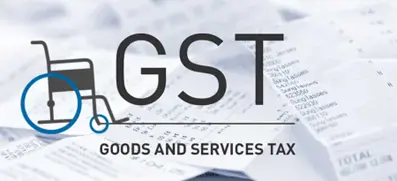
- This was intended to simplify and consolidate India's tax system but has inadvertently resulted in significant financial burden on disabled individuals.
- It is crucial to examine the impact of the GST regime on disabled individuals and address its discriminatory effects.
Impact of GST on Disabled Individuals and Broader Implications:
- Financial Burden on Essential Mobility Aids:
- Dependency on Aids: Disabled individuals rely heavily on mobility aids like prosthetic limbs, wheelchairs, and Braillers for daily functioning.
- Tax Implication: Under the current GST regime, these essential items are taxed at five percent. This tax adds an extra financial strain on individuals who already face numerous challenges.
- Example: A motorised wheelchair costing Rs 1 lakh incurs an additional Rs 5,000 as GST. If the wheelchair lasts for 500 kilometres, the effective tax burden per kilometre of mobility is Rs 10, highlighting the inequity since able-bodied individuals do not face such taxes for walking.
- Braille Publications: Blind individuals must also bear the GST burden on Braille publications, adding to their costs due to their disability.
- Discriminatory Nature of the Tax:
- Penalising Disability: The GST on disability aids imposes a financial burden on essential tools for achieving normalcy and independence, effectively penalising individuals for their disability.
- Unequal Treatment: Unlike able-bodied individuals, who do not incur additional costs for daily activities, disabled individuals face an inequitable tax burden, exacerbating their challenges.
- Constitutional Discrepancy: This tax is inconsistent with the principles of equality and non-discrimination enshrined in the Indian Constitution.
- Psychological and Social Implications
- Marginalisation: The additional cost on essential mobility and learning tools sends a message of marginalisation and inferiority to disabled individuals.
- Impact on Dignity: This tax undermines their dignity and self-worth, perpetuating negative stereotypes and social stigma associated with disability.
- Exclusion: Rather than fostering inclusion, this discriminatory tax policy reinforces barriers, hindering efforts towards societal integration, education, and economic participation for disabled individuals.
Analysis of GST Based on Constitutional Principles
- Fundamental Right to Equality (Article 14)
- Equality Before Law: Article 14 guarantees equality before the law and equal protection within India. The GST on disability aids creates unreasonable classification, disadvantages disabled individuals due to their condition.
- Reasonableness Test: The tax fails the reasonableness and equality test, imposing undue burdens on a vulnerable section of society.
- Fundamental Right to Non-Discrimination (Article 15)
- Prohibition of Discrimination: Article 15 prohibits discrimination based on various grounds, including physical disabilities. The tax directly contravenes this provision by discriminating against individuals based on their disabilities.
- Rights of Persons with Disabilities Act, 2016: This Act reinforces the prohibition of discrimination against disabled individuals, further supporting the argument against GST on disability aids.
- Indirect Discrimination and Judicial Interpretation
- Principle of Indirect Discrimination: Chief Justice D Y Chandrachud's 2021 judgement (Lt. Col. Nitisha v. Union of India) highlighted the need to recognize indirect discrimination.
- Application to GST: Even if the GST on disability aids is not overtly discriminatory, its disproportionate impact on disabled individuals constitutes indirect discrimination, reinforcing the need for review and reform.
The Judiciary's Stance on Similar Issues:
Sakal Papers Case (1961):
- Context:
- The Supreme Court of India struck down government-imposed restrictions on newspaper advertising, aimed at promoting smaller newspapers by limiting the number of advertisements larger ones could carry.
- Judgement:
- The Court ruled that these restrictions violated the fundamental right to freedom of speech and expression under Article 19(1)(a) of the Constitution.
- The regulation indirectly affected newspaper circulation and, consequently, the dissemination of information.
- Principle Established:
- Government actions that indirectly impact fundamental rights must be scrutinised and can be invalidated if deemed unreasonable.
Indian Express Case (1984):
- Context:
- The Supreme Court addressed a customs duty imposed on newsprint, which the government justified as a revenue measure.
- Judgement:
- The Court recognized that the duty increased newsprint costs, thereby raising newspaper prices and affecting public access to information.
- The duty was struck down for infringing on the right to freedom of speech and expression.
- Principle Reinforced:
- Policies with indirect consequences on fundamental rights must undergo rigorous scrutiny and justification.
Aashirwad Films Case (2007):
- Context: The Supreme Court reviewed a discriminatory tax levied on non-Telugu films in Andhra Pradesh.
- Judgement: The Court declared the tax unconstitutional, finding it "socially divisive" and a violation of the right to equality under Article 14 of the Constitution. The tax unfairly burdened non-Telugu films and their audiences.
- Principle Highlighted: Taxation or regulation creating unreasonable distinctions between different classes of people or entities must be invalidated.
Way Forward: Reform for Dignity and Empowerment
- Issue of Dignity:
- While GST revenue from disability aids is minimal compared to the total, the imposition of this tax on essential aids like wheelchairs and Braillers is a matter of dignity.
- Taxing disabled individuals for basic needs communicates a message of inferiority rather than empowerment.
- Judicial Precedent:
- The 2021 judgement on Article 15 (Lt. Col. Nitisha) emphasises the need to recognize indirect discrimination, reinforcing the argument against the discriminatory GST on disability aids.
Conclusion
The five percent GST on essential disability aids is a manifest injustice, penalising disabled individuals for their condition. This policy not only contravenes constitutional principles of equality and non-discrimination but also undermines the dignity of disabled individuals. Reforming this tax regime is crucial to ensuring that disabled individuals are treated with the dignity and respect they deserve
Source: IE
UN Water Convention
Why in the news?
- On July 19, 2024, Ivory Coast became the 10th African nation to join the United Nations Water Convention.
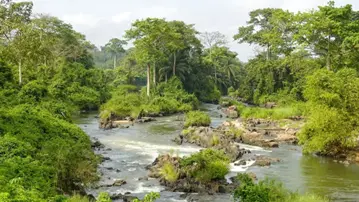
About the UN Water Convention:
- Full Name: Convention on the Protection and Use of Transboundary Watercourses and International Lakes
- Adopted: Helsinki, 1992
- Entered into Force: 1996
- Purpose: Promotes sustainable management of shared water resources, supports the implementation of Sustainable Development Goals (SDGs), prevents conflicts, and fosters peace and regional integration.
History:
- Origins: Initially a regional framework for the pan-European region.
- Global Accession: Since March 2016, all UN Member States can join.
- Notable Accessions:
- 2018: Chad and Senegal, the first African Parties.
- March 2023: Iraq, the first from the Middle East.
- June 2023: Namibia, the first from Southern Africa.
- July 2023: Panama, the first from Latin America.
Requirements for Parties:
- Prevent, Control, and Reduce: Manage transboundary impacts.
- Reasonable and Equitable Use: Ensure sustainable management of transboundary waters.
- Cooperation: Parties must cooperate by forming specific agreements and joint bodies with neighbouring states sharing the same transboundary waters.
Significance:
- Sustainable Development Goals: Helps achieve the 2030 Agenda for Sustainable Development.
- UNECE: The United Nations Economic Commission for Europe supports the Convention.
Ivory Coast's Context:
- Transboundary River Basins: Shares eight basins (Black Volta, Bia, Tanoe, Comoe, Niger, Sassandra, Cavally, and Nuon) with six neighbouring countries: Ghana, Burkina Faso, Mali, Guinea, Liberia, and Sierra Leone.
Source: DTE
Khelo India Rising Talent Identification (KIRTI) Program
Why in the news?
- On July 19, 2024, the Khelo India Rising Talent Identification (KIRTI) Program received a significant boost under the leadership of the Union Minister for Youth Affairs.
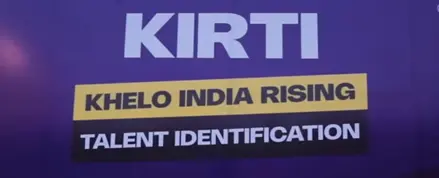
About KIRTI Program:
- Target Group: School children aged 9 to 18 years.
- Objectives:
- Talent Identification: Discover and nurture sports talent from every part of the country.
- Combat Distractions: Utilise sports to address issues related to drug addiction and excessive screen time.
Program Details:
- Initial Launch: The program was launched across 50 centres in India.
- Phase 1: Assessing 50,000 applicants in the first phase across 10 sports, including athletics, boxing, wrestling, hockey, football, and wrestling.
- Target for FY 2024-25: Conduct 20 lakh assessments nationwide through Talent Assessment Centres.
Key Features:
- Athlete-Centric Approach: Transparent selection process using Information Technology.
- Data Analytics: Artificial Intelligence is employed to predict athletic potential.
- Decentralised Approach: Focuses on pocket-based talent identification to support both sports excellence and mass participation
Source: PIB
Phlogacanthus Sudhansusekharii
Why in the news?
- Recently, the Botanical Survey of India (BSI) discovered a new plant species named Phlogacanthus sudhansusekharii, from Itanagar Wildlife Sanctuary in Arunachal Pradesh.

About Phlogacanthus Sudhansusekharii:
- Research Institution: Botanical Survey of India (BSI)
- Location: Itanagar Wildlife Sanctuary, Papum Pare district, Arunachal Pradesh
- Species Overview:
- Family: Acanthaceae
- Genus: Phlogacanthus
- Honoree: Named after Dr. Sudhansu Sekhar Dash, a BSI scientist recognized for his significant contributions to plant and ecological research in the Indian Himalayan region.
- Genus Information:
- Phlogacanthus: Includes 13 species in India, primarily in the northeastern and eastern Himalayan regions.
About the Itanagar Wildlife Sanctuary:
- Location: Naharlagun, near the capital city of Arunachal Pradesh
- Area: 140.30 sq. km
- Boundaries:
- East: Pam River
- South: Pachin
- Northeast: Neorochi
- North: Chingke stream
- Flora:
- Forest Types: Mix of evergreen and semi-evergreen forests
- Features: Hilly terrain with bamboo patches and a variety of orchid species
- Fauna:
- Wildlife: Tigers, leopards, clouded leopards, elephants, barking deer, sambar, hoolock gibbons, macaques
- Bird Species: Hornbills, eagles, pheasants.
Source: DH
Enemy Property Act, 1968
Why in the news?
- The Indian government has recently begun auctioning benami properties belonging to individuals who now hold Pakistani or Chinese passports.
- The Act was enacted in response to the Indo-China War of 1962 and the Indo-Pak Wars of 1965 and 1971.
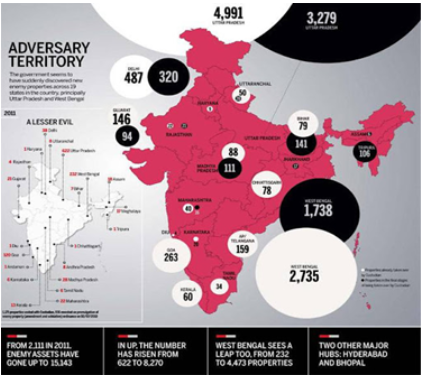
- Uttar Pradesh (5,982) has the highest number of enemy properties, followed by West Bengal (4,354).
- Most of these properties belong to people who migrated to Pakistan, and over 100 to those who migrated to China.
Definition of Enemy Property:
- Enemy Property: Refers to any property owned by or held on behalf of an enemy, enemy subject, or enemy firm.
- Enemy: Defined as any country that has committed an act of aggression or declared war against India.
- Property: Includes immovable assets and negotiable instruments like shares, debentures, and other commercial assets.
Provisions:
- Succession Rights: The Act states that the heirs of those who migrated to Pakistan or China lose their rights to inherit the property left behind by their ancestors.
- Scope: Encompasses property left by those who moved to China post-1962 Sino-Indian war and to Pakistan post-1965 and 1971 Indo-Pak wars.
- Custodian Role: The Custodian of Enemy Property for India (CEPI) took over the management of these properties and may sell or lease them to state governments for public use.
Enemy Property (Amendment and Validation) Act, 2017:
- Expanded Definitions: Enlarges the definition of "enemy subject" and "enemy firm" to include legal heirs and successors, regardless of nationality.
- Permanent Status: Once declared enemy property, the designation remains even if the enemy or their heirs change nationality, die, or the business is wound up.
Supreme Court Ruling:
- Ownership: The Supreme Court ruled that the CEPI does not acquire ownership of enemy properties but holds them in trust for management and administration.
- Union Ownership: The Union of India does not possess ownership rights over enemy properties.
Custodian of Enemy Property for India (CEPI):
- Function: Operates under the Ministry of Home Affairs.
- Authority: A statutory authority with powers equivalent to those of a civil court under the Code of Civil Procedure, 1908.
Source: (TH)
Deepfakes in elections shake trust in our judgment
In News: A recent article explores the emergence of deep fakes within our current election cycle and their potential to undermine the integrity of the electoral process. It delves into the difficulties posed by deep fakes in authenticating information and exercising personal discernment.
Understanding Deepfakes: Origins, Creation, and Impact on Elections
- Definition and Origins:
- Deepfakes are synthetic media generated using AI technology, aiming to deceive individuals by manipulating visual and audio content.
- The term "deepfake" was coined in 2017 by an anonymous Reddit user known as "Deepfakes," who utilized Google's deep-learning technology for creating and sharing pornographic videos.
- Creation Process:
- Deepfakes are created using generative adversarial networks (GANs), consisting of a generator and a discriminator neural network.
- The generator produces fake images or videos closely resembling reality, while the discriminator differentiates between authentic and fake content.
- Data Synthesis:
- The creation of deepfakes requires large datasets, often sourced from the internet or social media without consent, including photos or videos of both source and target individuals.
- Deep Synthesis:
- Deepfakes are part of Deep Synthesis, utilizing technologies like deep learning and augmented reality to generate text, images, audio, and video, constructing virtual scenarios.
Advantages of Deepfakes in Elections:
- Segmentation and Targeting:
- Deep learning algorithms enable political parties to analyze extensive voter data, including demographics and social media engagement, for personalized targeting.
- Natural language processing (NLP) algorithms interpret textual data from social media posts, news articles, etc., aiding in targeting voters effectively.
- Real-time Monitoring and Adaptation:
- AI-powered predictive analytics forecast election outcomes by analyzing diverse factors like polling data and social media sentiment analysis.
- AI algorithms continuously monitor data sources to gauge public sentiment and identify emerging trends.
- Enhanced Communication Strategies:
- AI chatbots and virtual assistants engage voters on social media platforms, disseminating information about candidates and policies.
- Security and Integrity:
- AI-driven tools detect and prevent electoral fraud, ensuring the integrity of elections.
- Regulation and Oversight:
- AI technologies monitor political advertising, ensuring compliance with electoral regulations.
Challenges related to Deepfakes in Elections:
- Electoral Behavior Manipulation:
- Deepfake content can manipulate voters by spreading personalized propaganda.
- Spreading Misinformation:
- Generative AI models can spread disinformation, influencing voter perceptions.
- Inaccuracies and Unreliability:
- Deepfake AI models are susceptible to inaccuracies, posing risks to reliability.
- Ethical Concerns:
- Deepfake usage raises ethical questions regarding privacy, transparency, and fairness.
- Regulatory Challenges:
- Regulating deepfakes in electoral campaigns is challenging due to rapid technological advancements.
Combatting the Misuse of Deepfakes in Elections:
- Regulatory Measures:
- Implement strict laws criminalizing the creation and dissemination of deepfake content during elections.
- Election Commission Guidelines:
- Issue guidelines requiring transparency in AI algorithms used for political purposes.
- Technology-Based Solutions:
- Develop AI algorithms to detect and authenticate deepfake content in real-time.
- Awareness and Education Campaigns:
- Launch public awareness campaigns to educate voters about deepfake technology.
- Enhanced Fact-Checking:
- Establish rapid response teams to address the dissemination of fake news and deepfakes.
- Collaborative Efforts:
- Foster collaboration among governments, tech companies, and civil society organizations to combat deepfake threats.
- Learning from International Practices:
- Draw insights from international approaches to deepfake regulation and prevention.
- Promoting Ethical AI:
- Advance AI technologies with ethical principles, prioritizing objectives like mitigating bias and safeguarding privacy.
|
UPSC Previous Year Questions Prelims (2020) Q. With the present state of development, Artificial Intelligence can effectively do which of the following?
Select the correct answer using the code given below: (a) 1, 2, 3 and 5 only Ans: (b) Mains (2021) Q. What are the main socio-economic implications arising out of the development of IT industries in major cities of India? |
Source: IE
Reforming Urban Governance
Context:
- In the past three decades, India has evolved from a stagnant economy to the third largest globally, with urbanisation increasing significantly.
- By 2036, 600 million people (40% of the population) will reside in urban areas, contributing nearly 70% to GDP, up from 31% in 2011.
- Effective urban governance is crucial for managing infrastructure, ensuring the maintenance of essential systems like roads, water supply, and sanitation, and promoting sustainability.
- Despite progress, cities still grapple with challenges such as poor governance, inadequate infrastructure, and insufficient services.
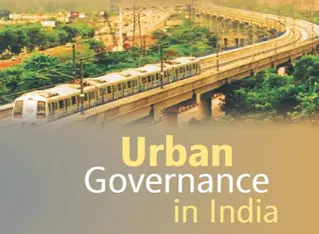
What is Urban Governance?
- About:
- Urban governance refers to the systems, processes, and practices used to manage and develop cities.
- It involves decision-making frameworks and institutions that guide urban planning, service delivery, and overall urban administration.
- Significance:
- Quality of Life: Enhances the living standards of residents.
- Urban Resilience: Improves the city's ability to withstand and recover from challenges.
- Sustainable Development: Promotes environmental sustainability and social equity.
- Key Elements:
- Stakeholders: Includes local governments, citizens, businesses, and non-governmental organisations (NGOs).
- Policies and Regulations: Covers laws and regulations related to land use, zoning, housing, transportation, and environmental management.
- Service Delivery: Manages essential services such as water supply, waste management, transportation, and public safety.
- Participatory Governance: Encourages citizen involvement in decision-making to ensure transparency and accountability.
- Sustainability: Aims to balance economic growth with social equity and environmental protection.
Present Mechanism of Urban Governance in India:
- 74th Constitutional Amendment Act, 1992:
- Introduction: The amendment inserted Part IX-A into the Constitution, establishing urban local bodies (ULBs) as institutions of local self-government.
- Articles Added: Introduced Articles 243P to 243ZG and a new Twelfth Schedule to the Constitution.
- Empowerment: Provided states with the authority to delegate 18 functions, including urban planning, land use regulation, water supply, and slum upgradation, to ULBs.
- Types of Urban Local Bodies:
- Municipal Corporation: Manages large cities like Bangalore, Delhi, Mumbai, and Kolkata.
- Municipality: Operates in smaller cities, known by various names such as municipal council, municipal committee, or municipal board.
- Notified Area Committee: Established for rapidly developing towns or those lacking basic amenities.
- Town Area Committee: Found in smaller towns with limited authority.
- Cantonment Board: Manages civilian areas within cantonments.
- Township: Provides basic facilities to staff and workers in colonies near industrial plants.
- Port Trust: Manages ports in coastal areas.
- Special Purpose Agency: Handles specific functions or activities related to municipal corporations or municipalities.
Steps Taken to Improve Urban Governance:
- Smart Cities Mission (SCM):
- Launch Year: 2015
- Objective: Transform 100 cities to enhance core infrastructure and create a clean and sustainable environment through "Smart Solutions."
- Focus: Sustainable and inclusive development to improve citizens' quality of life.
- Allocation of Funds for Pollution Control:
- Date: December 2023
- Scope: Identified 131 million-plus/non-attainment cities (those exceeding National Ambient Air Quality Standards (NAAQS) for five consecutive years).
- Action: Prepared City Specific Clean Air Action Plans and allocated funds to improve air quality.
- Pradhan Mantri Awas Yojana (PMAY):
- Objective: Housing for All by 2022
- Implementation: Ministry of Housing and Urban Affairs (MoHUA)
- Benefit: Provides home loan interest subsidies to make urban housing affordable for the poor.
- Swachh Bharat Mission-Urban (SBM-U):
- Launch Year: 2014
- Ministry: Ministry of Housing and Urban Affairs
- Objective: Promote cleanliness, sanitation, and proper waste management in urban areas.
- Urban Platform for Delivery of Online Governance (UPYOG):
- Purpose: National reference platform for delivering municipal services online.
- Principle: Utilises National Urban Innovation Stack principles.
- AMRUT Scheme:
- Full Form: Atal Mission for Rejuvenation and Urban Transformation
- Launch Year: 2014
- Objective: Ensure every household has access to tap water and sewerage connections.
Challenges in Urban Governance:
- Lack of Autonomy:
- Issue: Urban governance is part of the state list in the Indian Constitution, leading to varied administrative frameworks and limited autonomy for Urban Local Bodies (ULBs).
- Impact: Many city-level functions are managed by state-controlled parastatals, reducing local management control.
- Draining Financial Resources:
- Issue: India has the world's lowest property tax collection rate. An RBI survey revealed a significant decline in municipal corporation revenues with rising expenditures.
- Impact: Limited property tax coverage and inadequate taxation powers stress municipal finances.
- Multiplicity of Agencies:
- Issue: Special-purpose agencies under state supervision complicate governance and financial management.
- Examples: Entities like the State Transport Corporation and Water Supply Department create financial and operational challenges for municipal bodies.
- Unplanned Urbanisation:
- Issue: Rapid urban growth without proper planning leads to inadequate municipal services and infrastructure.
- Examples: Delhi's 1,799 unauthorised colonies and issues with water pipeline projects highlight the strain on urban services.
- Environment Concerns:
- Issue: High pollution levels and poor waste management affect urban quality of life.
- Statistics: Urban India generates about 42 million tons of municipal solid waste annually, with 72% coming from tier-I cities. Recent studies show a rise in PM2.5 levels in NCAP cities.
- Low Public Participation:
- Issue: Despite high literacy rates, residents often show limited engagement with urban governance.
- Impact: Insufficient public involvement in waste management and pollution control exacerbates governance challenges.
Way Forward for Urban Governance:
- The Three F’s for Urban Governance:
- Concept: Transfer of 'Functions, Finances, and Functionaries' to city governments.
- Example: The People’s Planning model in Kerala, where 40% of the State’s plan budget was allocated directly to local bodies, empowering them with significant responsibilities such as planning and execution.
- Investing in Infrastructure:
- Requirement: According to the World Bank, India needs to invest approximately $55 billion (1.2% of GDP) annually in urban infrastructure.
- Current Financing: Central and state governments finance 72% of urban projects, with only 5% coming from commercial sources.
- Recommendation: Increase the role of private capital in funding urban infrastructure to ensure sustainable development.
- Strengthening Municipal Revenue:
- Model: Scandinavian countries effectively manage urban functions by allocating a portion of income tax revenue to urban governments.
- Property Tax: Finance Commissions advocate for enhancing property tax revenues to improve municipal finances.
- Example: The 12th Finance Commission encouraged the use of Geographical Information System (GIS) and digitisation to enhance property tax administration.
- Strategic Property Management:
- Challenge: Local bodies often hold underutilised properties.
- Solution: Monetise these properties through public-private partnerships (PPP) to develop commercial spaces, markets, or parking lots.
- Recommendation: The World Bank suggests using PPPs for financing and expertise in infrastructure projects. The 14th Finance Commission also recommended enabling municipalities to levy a vacant land tax.
- Capacity Building for Urban Local Bodies (ULBs):
- Objective: Improve both institutional and human capacity within ULBs.
- Action: Focus on developing the skills required to execute bankable projects effectively and efficiently.
- Municipal Bond and Social Stock Exchange (SSE):
- Municipal Bonds: Debt securities issued by state or local governments to finance capital expenditures, such as infrastructure projects.
- Social Stock Exchange (SSE): Platform for social enterprises to raise capital focusing on social impact alongside profit generation.
- Recommendation: Develop the municipal bond market and SSE to attract investments for local needs and generate revenue for local bodies.
- Need for Behavioural Change:
- Approach: Treat cities as crucial centres of governance where democratic decentralisation and active people’s participation can drive transformation.
- Example: The Indore model of waste management, a decentralised and community-driven approach, demonstrates the potential for significant improvements through local engagement and innovation.
|
UPSC Civil Services Examination, Previous Year Question (PYQ) Prelims: Q:1 The Constitution (Seventy-Third Amendment) Act, 1992, which aims at promoting the Panchayati Raj Institutions in the country provides for which of the following? (2011)
Select the correct answer using the codes given below:
Ans: C
Mains: Q:1 Do government’s schemes for up-lifting vulnerable and backward communities by protecting required social resources for them, lead to their exclusion in establishing businesses in urban economies? (2014) Q:2 Discuss the recommendations of the 13th Finance Commission which have been a departure from the previous commissions for strengthening the local government finances. (2013) |
Source: HT
Black Sea
In News: After Russia withdrew its larger warships from the Black Sea due to a series of devastating attacks, Ukraine's exploding drone boats seem to be targeting smaller, high-speed vessels in the region.
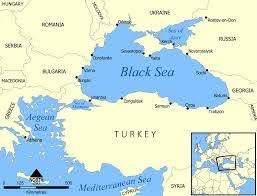
About the Black Sea
- Location and Size
- The Black Sea is a vast inland sea situated at the southeastern edge of Europe, covering an approximate area of 436,000 square kilometers (168,000 square miles).
- Bordering Countries
- It shares its borders with Ukraine to the north, Russia to the northeast, Georgia to the east, Turkey to the south, and Bulgaria and Romania to the west.
- Notably, Russia boasts the longest coastline on the sea, spanning 2,300 kilometers, followed by Turkey with 1,329 kilometers and Ukraine with 1,282 kilometers.
- Geographical Features
- The Crimean Peninsula extends into the Black Sea from the north.
- The sea is connected to the Aegean Sea, an arm of the Mediterranean, through the Bosporus Strait, the Sea of Marmara, and the Dardanelles Strait.
- Additionally, it connects with the Sea of Azov via the Kerch Strait.
- Formation and Salinity
- The Black Sea was formed due to structural upheavals in Asia Minor, which separated the Caspian basin from the Mediterranean.
- Over time, it became isolated, resulting in a salinity level that is less than half that of the world's oceans.
- Hydrology
- The sea receives freshwater inflows from various rivers, including the Danube, Southern Bug, Dnieper, Rioni, and Dniester.
- It is renowned as the largest meromictic basin globally, characterized by rare water movement between its lower and upper layers.
- Ecological Characteristics
- The Black Sea is one of the world's largest anoxic basins, with areas exhibiting very low levels of dissolved oxygen.
- Islands
- Several islands dot the sea, with notable ones including Snake Island (Ukraine), Giresun Island (Turkey), and St. Ivan Island (Bulgaria).
Source: BI
Can India become a green superpower?
In News: India should strive to emerge as a green superpower by leveraging its potential to offer low-cost green hydrogen amid the global shift towards cleaner energy.
Why India Should Aim to be a Green Superpower
- Amitabh Kant's Perspective
- During the 'Raisina Dialogue 2024', Amitabh Kant, former NITI Aayog chief and G20 Sherpa, stressed India's need to become a net exporter of green energy by 2047 to attract capital.
- He emphasized that future investments would gravitate towards renewable energy sectors, making green approaches essential for capital attraction.
- Addressing the Global Challenge
- The pressing global challenge of climate change necessitates a shift towards renewable energy sources.
- Kant proposed transitioning the World Bank into a climate bank and advocated for each country, particularly those in the global south, to prioritize renewable energy.
- Biofuels as a Solution
- Kant highlighted the significant role of biofuels in creating jobs and achieving clean fuel targets, suggesting their importance in India's renewable energy strategy.
- Economic and Environmental Imperatives
- As the world moves towards cleaner energy, India has the potential to become a major producer of green hydrogen, contributing to both economic growth and environmental sustainability.
- India's Renewable Energy Growth
- India is currently implementing the world's largest renewable energy expansion program, aiming to install 500 GW of renewable capacity by 2030.
- This includes substantial investments in solar and wind energy and plans for green hydrogen production.
Steps for Achieving the Goal
- Financing the Green Transition
- Mobilizing financing is crucial for scaling up renewable energy investments, involving both local and international finance sources.
- Policy Tools for Driving Investment
- Enforcing Renewable Purchase Obligations (RPO) and Energy Storage Obligations (ESO) can boost demand for renewable energy and accelerate technological advancements in energy storage.
- Strengthening Infrastructure and Fiscal Reforms
- Enhanced public-private partnerships (PPPs) and fiscal incentives for clean energy can promote investment in low-carbon transport infrastructure and renewable energy projects.
- Institutional and Regulatory Strengthening
- Strengthening institutions like the Bureau of Energy Efficiency (BEE) and regulatory bodies will be crucial for scaling up clean energy projects and attracting investments.
- Leveraging Global Financial Mechanisms
- Increasing the role of global multilateral institutions and exploring mechanisms like multi-sovereign loan guarantees can improve access to finance for renewable energy projects.
- Policy and Regulatory Support
- Implementing policies and regulations that promote renewable energy technologies, including energy conservation codes and tariff policies, can further incentivize investment in green energy.
Conclusion
India's transition to a green superpower is not only about transforming its energy landscape but also about leading globally in sustainable development. Green infrastructure investments have significant economic benefits and contribute to building resilience against climate change.
Source: DH
Share the article
Edukemy’s Current Affairs Quiz is published with multiple choice questions for UPSC exams
MCQ
Get Latest Updates on Offers, Event dates, and free Mentorship sessions.

Get in touch with our Expert Academic Counsellors 👋
FAQs
UPSC Daily Current Affairs focuses on learning current events on a daily basis. An aspirant needs to study regular and updated information about current events, news, and relevant topics that are important for UPSC aspirants. It covers national and international affairs, government policies, socio-economic issues, science and technology advancements, and more.
UPSC Daily Current Affairs provides aspirants with a concise and comprehensive overview of the latest happenings and developments across various fields. It helps aspirants stay updated with current affairs and provides them with valuable insights and analysis, which are essential for answering questions in the UPSC examinations. It enhances their knowledge, analytical skills, and ability to connect current affairs with the UPSC syllabus.
UPSC Daily Current Affairs covers a wide range of topics, including politics, economics, science and technology, environment, social issues, governance, international relations, and more. It offers news summaries, in-depth analyses, editorials, opinion pieces, and relevant study materials. It also provides practice questions and quizzes to help aspirants test their understanding of current affairs.
Edukemy's UPSC Daily Current Affairs can be accessed through:
- UPSC Daily Current Affairs can be accessed through Current Affairs tab at the top of the Main Page of Edukemy.
- Edukemy Mobile app: The Daily Current Affairs can also be access through Edukemy Mobile App.
- Social media: Follow Edukemy’s official social media accounts or pages that provide UPSC Daily Current Affairs updates, including Facebook, Twitter, or Telegram channels.

